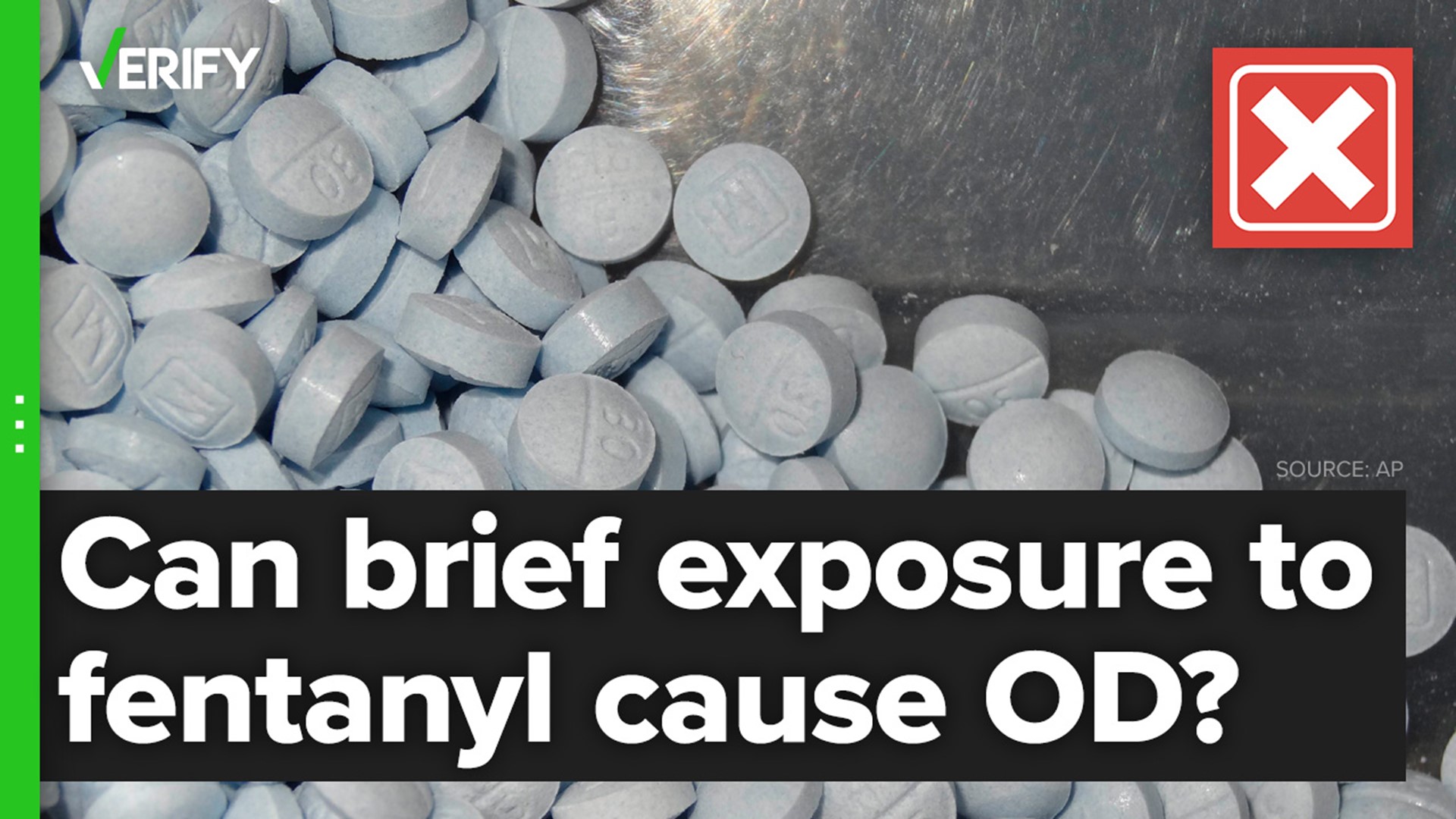Over the past few years, some sheriff's departments have issued warnings about the dangers of fentanyl alongside videos that appear to show law enforcement officers suffering some kind of accidental overdose or reaction while exposed to the highly addictive drug.
Most recently, in December 2022, a police department in Florida released a video of an officer apparently suffering an overdose “as a warning about how dangerous fentanyl can be.”
The videos and warnings sparked conversations about whether brief exposure to fentanyl could cause an overdose or death.
The posts coincide with Centers for Disease Control and Prevention (CDC) reporting that drug overdose deaths in the U.S. have risen by at least 15% in each of the last two years. According to the CDC, more than 80,000 of those overdose deaths were related to synthetic opioids, primarily fentanyl.
THE QUESTION
Can briefly being exposed to fentanyl cause an overdose?
THE SOURCES
- Ryan Marino, medical toxicologist, addiction medicine specialist, assistant professor at Case Western Reserve University School of Medicine
- Leo Beletsky, associate professor at the University of California San Diego School of Medicine
- American College of Medical Toxicology and American Academy of Clinical Toxicology
- 2021 study by RTI International and University of California San Diego
- 2020 study on fentanyl misinformation
- University of Michigan Health
- National Institute on Drug Abuse
THE ANSWER
No, medical experts say briefly being exposed to fentanyl cannot cause an overdose.
WHAT WE FOUND
“Science is very clear that you cannot overdose by touching fentanyl,” said Leo Beletsky, associate professor at the University of California San Diego School of Medicine. “It’s technically impossible to touch fentanyl powder and feel any effects of it, let alone overdose.”
Ryan Marino, a medical toxicologist and addiction medicine specialist who is also an assistant professor at Case Western Reserve University School of Medicine, said skin provides a protective barrier.
“You cannot just touch fentanyl and overdose,” he said.
Beletsky said he believes some confusion arises because of fentanyl patches, which the University of Michigan Health says are used to treat moderate to severe chronic pain around the clock and should only be used by people who have a prescription. But there are important differences between fentanyl patches and touching fentanyl, Beletsky says.
“The key difference there is first of all, that the patches are specifically designed medical devices that have liquids that transport fentanyl across your skin into your bloodstream,” he explained. “So, there's a specific vehicle to bring fentanyl across your skin. That's one. And two, even these powerful patches work in a matter of hours -- definitely not minutes and certainly not seconds in a way that, you know, these videos of fentanyl contact purport this process to unfold.”
Furthermore, Marino said a person being briefly exposed to fentanyl wouldn’t overdose either.
“They don't just get into the air, you can't breathe them in by accident,” he said. “The only way to overdose would be through injecting, snorting or otherwise ingesting if they were pressed into a pill form and you took it by mouth for example.”
A 2017 joint statement from the American College of Medical Toxicology and the American Academy of Clinical Toxicology concluded being around fentanyl could not result in an overdose.
“For opioid toxicity to occur the drug must enter the blood and brain from the environment,” the statement said. “Toxicity cannot occur from simply being in proximity to the drug.”
So, where did the idea come from that brief fentanyl exposure could lead to an overdose? Beletsky and Marino were authors of a study published in 2020 that said a 2016 warning from the Drug Enforcement Administration (DEA) has inaccurate information regarding the overdose risk from brief exposure to fentanyl. The warning links to a video of two detectives’ anecdotal reports of being exposed to fentanyl, but the video is no longer available.
The DEA warning also said, “Just touching fentanyl or accidentally inhaling the substance during enforcement activity or field testing the substance can result in absorption through the skin and that is one of the biggest dangers with fentanyl."
A DEA spokesperson told VERIFY that the video associated with the warning was “removed to prevent confusion since the scientific understanding of fentanyl exposure has evolved.” The agency said it follows CDC guidelines for preventing occupational exposure to fentanyl.
Updated guidance from the DEA says that “inhalation of airborne powder is most likely to lead to harmful effects, but is less likely to occur than skin contact.”
In the 2017 joint statement, the American College of Medical Toxicology and the American Academy of Clinical Toxicology said they had “not seen reports of emergency responders developing signs or symptoms consistent with opioid toxicity from incidental contact with opioids.”
In a 2021 study, researchers with RTI International, a nonprofit research group in North Carolina, and the University of California San Diego said there are no confirmed cases of first responders overdosing after touching fentanyl.
In July 2021, the San Diego County Sheriff's Department claimed that a deputy nearly died processing fentanyl, and released a now-deleted video of the incident while warning about the drug's dangers.
The San Diego County sheriff told the San Diego Union-Tribune that he, not a doctor, concluded the deputy overdosed from incidental contact with fentanyl. The sheriff’s department also said the hospital where the deputy was treated did not conduct a toxicology test.
Beletsky said signs of an opioid overdose include a person going into a limp and sleepy state, shallow breathing, and blue lips and fingertips. People suffering from an overdose are often treated with naloxone, a medicine that can reverse an opioid overdose and allow a person to resume normal breathing, according to the National Institute on Drug Abuse.
To learn where you can find naloxone, or Narcan, in your area, search the National Harm Reduction Coalition’s map here.
If you or someone you know is dealing with addiction, you can find help and support via the SAMHSA national helpline by calling 1-800-662-HELP.

